thumbnail
Farming Business Management
Pork producers urge USTR to recommit to aggressive trade agendaPork producers urge USTR to recommit to aggressive trade agenda
In 2023, exports added the equivalent of $63.76 to the price producers received for each hog marketed, accounted for a record 29.6% of total production.
Subscribe to Our Newsletters
National Hog Farmer is the source for hog production, management and market news













.jpg?width=300&auto=webp&quality=80&disable=upscale)



























